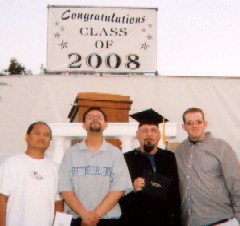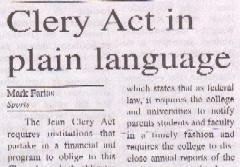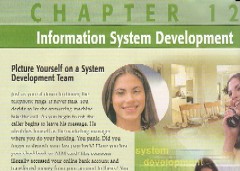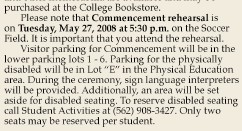The New World of Instructional Technology
I received my education in plain classrooms with slate blackboards. When I was a child our desks had holes for inkwells, although we didn't use the inkwells themselves. When I returned to school in 2003, the Internet was part of the landscape. So, we should be light years ahead in educational achievement. Right?
Which technology, for better or worse, has had the greatest impact on education? The Internet? On-line classes? Powerful scientific calculators? Overhead projectors? The word processor? The personal computer? The DVD? All of these are technologies which didn't exist when I first went to school.
In my opinion, the one technology which has had the greatest impact on education is the Scantron machine. Or, perhaps to be more general, the widespread use of multiple-choice testing which Scantron and other platforms support. This technology allows many more students to be tested than was practical fifty years ago. However, the testing paradigm they support only tests one aspect of learning, recognition memory.
For example, here are a couple of actual multiple choice questions from a CIT 101 test:
1. A(n) _____ verifies that a required field contains date. (Answer: completeness check)
2. Deleting unneeded files _____ storage space. (Answer: reduces the size of files and frees up)
Here's a question which was never posed in CIT 101: “Your brother, father and grandmother are each planning to buy a new computer. Can you give each of them some recommendations about what to buy or not buy?”
This kind of open ended question allows many different aspects of computing to be explored: accelerated hardware (for gaming), business applications, recreational computing, the need for computer security. In other words, applying knowledge learned to real-world problems.
From my own experience and observation, I see how students orient themselves to learning by multiple choice. Scanning the textbook for defined terms and key words will probably assure a passing grade on a test. But is this learning?!! Is it any wonder that some students will come to class wearing iPod earphones? It doesn't matter what an instructor has to say, if you can pass the course with a multiple-choice test.
I had one teacher who was “old school,” Mr. Mosharraf, for calculus. Although multiple choice tests are widely used in mathematics classes, Mr. Mosharraf's tests required worked out solutions which he hand graded. As a result, Mr. Mosharraf had an in-depth understanding of both class and individual areas of strength and weakness. During lectures, he would frequently elaborate one area or another saying “some of you are having trouble with...” In my opinion, it is this kind of focused attention which makes teaching effective.
So if we throw out all of the Scantron machines, the student's will flourish? Not at all! I view this as an evolving technology. We have the ability now to automate testing which allows free-form responses. Students' responses can be parsed and analyzed using the same technology that search engines use for analyzing queries. Eventually artificial intelligence engines may “read” students' responses.
In the interim, however, good teachers seem to use a blend of both automated and traditional testing.
I see the word processor as another technology which has had a strategic impact on learning.
It's fascinating to watch the students in the computer lab working on their writing assignments. What's immediately obvious is that they are massively multi-tasking. With their iPods, text messaging, IRC chats, working on their writing assignment is occupying only a small part of their consciousness. When they do write, with their word processor, the computer screen becomes a blank slate, or sand box, which they utilize to form written structures.
Compare this with fifty years ago. Our “word processor” was pencil and paper. Of course, we submitted assignments typewritten, but the typewriter was used to produce the finished product. You could never use the typewriter as a blank slate, since any changes or corrections were difficult to make. (Worse yet if you used carbon paper!)
The writing assignments of fifty years ago involved a great deal of forethought and rumination. By the time we picked up pencil and paper we had a general form or shape in our mind of what we wanted to write. We even wrote outlines!
The word processor is only one example of tools which affect what I call the “in cranio” vs. “in silico” balance. Another is the use of powerful scientific calculators in mathematics classes. For example, on my first examination in pre-calculus, we were asked to solve a very traditional problem. Given a rectangular sheet of paper, what size squares should be cut out of each corner to produce a box with maximum volume. I knew, from my prior training, that this was a simple maxima/minima problem. However, this was pre-calculus. We hadn't yet introduced differentiation which would be necessary to solve this problem. I struggled trying to figure out how to solve the problem with the tools we had been taught. I couldn't.
The same problem appeared on the final exam. By that time I knew how to solve the problem. After setting up the basic equation for volume, enter that equation into a scientific calculator and let the calculator find the maximum value.
I wonder if the use of technology, and this more “problem solving” approach, are responsible for the elimination of theorem proving in mathematics classes. I can remember when knowing how to prove theorems was an essential part of understanding mathematics.
I honestly don't know which is better, “in cranio” vs. “in silico,” but I know that they represent very different ways of working—indeed of thinking. I suspect those cognitive differences spill over into how one interacts with the world at large.
§ § §
I took one physics class which had a hands-on laboratory. This was the only place on campus where I saw Apple computers being used. The tools available in this computer-based physics laboratory were stunning. Motion sensors, accelerometers, data manipulation and reduction software. Wow! But again, “in cranio” vs. “in silico,” is it learning? One of our first physics experiments involved estimating the gravitational constant, g. We used a video of something like a tennis ball being fired into the air. We used software to digitize data points, did some numerical calculations and had an estimate for g.
When I took physics in high school, we did a similar experiment. As I recall we dropped a weight to which was attached a paper tape. (So called “ticker tape” was then readily available.) The tape passed between the clapper and gong of an ordinary household doorbell. As the weight dropped, “dimples” were pounded into the paper tape. Knowing that the bell rang at the rate of household alternating current (60 Hz), and measuring the space between the dots, allowed us to graph distance vs. time and ultimately estimate g. Whew! So much work to do what the Apple computer can do in a few milliseconds. But which version of this experiment results in “deeper” learning? Another case of “in cranio” vs. “in silico.” I don't have the answer to this question—I'm just glad that I've had the opportunity to do this experiment both ways.
§ § §
When I first learned that some classes at Rio Hondo College were taught “on-line,” I was skeptical. Without human interaction, is this really a class? Why don't I just read the textbook and take the tests?
My first on-line class was CIT 101, the introductory “computer literacy” class. It was very reminiscent of a so called “home study” course which I took in the 1960's. A number of very structured “modules,” punctuated by assignments and examinations which were mailed to the school for grading and feedback. The computer, of course, speeds up this process. And there's another twist: discussion groups.
For reasons which I don't quite understand, students are required to participate in discussions. Honestly, if I wanted to participate in discussions, I would attend the class on campus. Also, the discussion paradigm on-line isn't the same as in the classroom. On-line discussions (“threads”) may evoke new ideas, but they're not moderated by a knowledgeable, trusted source (the instructor), and so it leaves open the possibility of propagating mis-information.
On one occasion I shared my opinion, in the discussion group, that our textbook, indeed the entire class, was very oriented towards Microsoft products. The instructor contacted me, by e-mail, outside of the discussion group, to defend the course. I still have no idea why the instructor didn't participate in the discussion, as she would have in class, to keep the record straight.
The second on-line class I took was introductory accounting. The instructor was lax in responding to questions. I fell behind during the first week. I knew that falling behind in an on-line class would be difficult to catch up. Frequently, on campus classes fall behind, and the instructor adjusts accordingly. That doesn't happen on-line. I dropped the class and eventually took accounting on campus. In retrospect, at least for me, it was better to have the real-time interaction with the instructor for this type of class.
The third class I took on-line was English 101. I felt that this type of subject matter was very well suited to on-line teaching. The instructor, Dr. Dana Vazquez conducted this class in a very professional manner. On the one occasion when I wanted to discuss an essay in more detail, I met with her on campus. Any doubts I had about the effectiveness of on-line classes were put to rest.
§ § §
All of this new technology has enabled much more sophisticated cheating! Apparently students have used text messaging during examinations. The seemingly infinite Internet gives students an opportunity to plagiarize with little chance of getting caught. But wait! One of my instructors required that we submit our term papers through the website www.turnitin.com, where authenticity is verified. I can see this as a kind of arms race, with each side deploying ever more sophisticated weapons.
In the case of on-line classes, how does an instructor prevent cheating when you never meet the students? In fact, I have a more basic concern. How does one verify that the person completing the course is the person enrolled? I could imagine establishing a business where students in third-world countries complete on-line courses for American students. (The use of proxy servers would anonymize their location.)
It's all a brave new world. What's the future of on-line education? In my opinion it's Second Life. And that's a whole other story!






